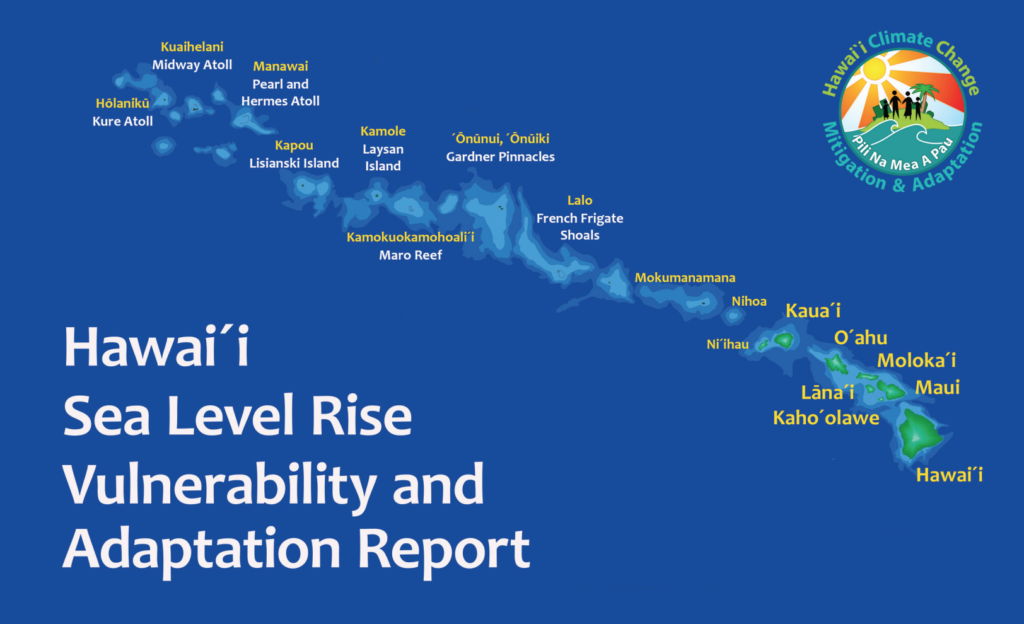Report Reveals Hawai‘i’s Future as Sea Level Rises
 The Hawai‘i Climate Change Mitigation & Adaptation Commission (Climate Commission) has accepted its first major report since it formed last fall.
The Hawai‘i Climate Change Mitigation & Adaptation Commission (Climate Commission) has accepted its first major report since it formed last fall.
The Sea Level Rise Vulnerability & Adaptation Report is a comprehensive 304-page-long description of where Hawai‘i is today and where we will be in the future as sea level rise (SLR) increases with global warming.
The report, developed under the leadership of the Hawai‘i Department of Land and Natural Resources Office of Conservation and Coastal Lands (OCCL), was initially mandated by Act 83 in 2014 and was expanded by Act 32 in 2017 and provides the first statewide assessment of Hawai‘i’s vulnerability to sea level rise. It includes recommendations to reduce exposure to sea level rise along with recommendations to increase our capacity to adapt.
Initiated under the Interagency Climate Adaptation Committee (ICAC), which then morphed into the Climate Commission, the SLR report provides recommendations to improve our resiliency to sea level rise based on a combination of advanced planning practices and risk exposure reduction initiatives which were framed through extensive stakeholder consultations over a three-year period.
DLNR Chair Suzanne Case co-chairs the Climate Commission with State Office of Planning Director Leo Asuncion.
“While the SLR report focuses on sea level rise vulnerabilities and adaptation, it should also strengthen Hawai‘i’s resolve to do our part in reducing greenhouse gas emissions in line with Act 32 and the Paris Agreement,” said Case.
“This report is intended to serve as a framework for identifying and managing other climate change threats facing Hawai‘i,” Asuncion said.
The SLR report was completed in advance of the Dec. 31, 2017, deadline.
The report’s executive summary states:
“Shorelines are one of our planet’s most dynamic physical features and Hawai‘i’s are no exception. Communities along our shores have flourished for centuries in harmony with the ebb and flow of the tides, punctuated by the occasional devastating hurricane or tsunami event. However, rapid warming of the atmosphere and oceans, caused by two centuries of unabated carbon emissions, is causing increasing rates of sea level rise, unprecedented in human history, threatening natural environments and development on low-lying coasts.”
The authors of the report note that much of what happens with future SLR depends on the ability or inability of nations to implement aggressive carbon emissions reductions, envisioned through the 2016 Paris Agreement.
Hawai‘i and a group of 16 US states are part of a US Climate Alliance that is honoring the US commitment, made under President Barak Obama, to reduce its carbon emissions under the guidelines of the Paris Agreement.
The report can be downloaded here.
Additionally, the DLNR is releasing a half-hour television special, Rising Seas in Hawai‘i, in mid-January. It is scheduled for three broadcasts on KFVE-TV (K5) at 7 p.m. on Jan. 17, at 9:30 p.m. on Jan. 20 and at 4 p.m. on Jan. 21. The special chronicles the stories of people and places already dealing with sea level rise and features some of the adaptation recommendations included in the Sea Level Rise Vulnerability & Adaptation Report.
Sponsored Content
Comments








